Anatomy of an Era: Professor Ken Dewey, Part 1
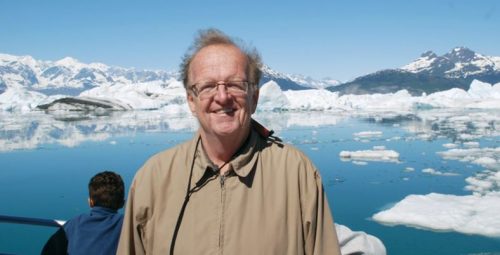
Excerpted from Chapter 89, No Place Like Nebraska: Anatomy of an Era, Vol. 2 by Paul Koch
Every thing seems colossal on this great continent; if it rains, if it blows, if it thunders, it is all done fortissimo; but I often felt terror yield to wonder and delight, so grand, so glorious were the scenes a storm exhibited…but not so much so as reasonably to bring terror home to one’s bosom every time a mass of lurid clouds is seen rolling up against the wind.
-Francis Trollope, Domestic Manners of the Americans
By this point you are aware of my tendency to go off the beaten path in search of a clue, a notion, an inkling, and indication of the more refined things, the smallish details that trickle into the craws and crevices to eventually make their home, their presence felt with the passing of days and years, the freezes and the thaws.
Sure, one could point out the many and varied cultural and societal influences on the players of that 60 & 3 era: the advent of ESPN’s SportsCenter highlight show and its effect on young athletes’ attentions, popular music’s pervasive impact via prevalence of the hard rock acts Metallica, AC/DC, Guns N’ Roses and Pantera, the surge of Hip-Hop and the urban-fueled Rap music of N.W.A. (Niggaz With Attitude), Snoop Dogg, Public Enemy and Digital Underground, as well as acceptance of newfound health & fitness-minded lifestyles, with skyrocketing gym memberships and popular shoes such as Nike’s Air Jordan’s and the Rebook Pump.
This slice of a generation grew up during America’s ‘winning’ of the Cold War with Russia due to Ronald Reagan’s (and George H.W. Bush’s) brash challenges and economic gamesmanship, and had also just experienced a fully-televised and conclusive, dominating war victory over Iraq’s invading armies of Kuwait during the short-lived Persian Gulf War’s Operation Desert Storm in 1990-1991. All these and more had their effects on the youth of the day, but in thinking deeply about influences outside the playing field, the film room, the weight room, the locker room and all other campus locales, I came upon a subject that has been a part of Nebraska far before it was even Nebraska: the weather.
You’d be hard-pressed to find a subject (other than football) as popular and talked-about in the cafes and homes and sidewalks and pick-up trucks of Nebraska than the region’s ever-changing weather. Both a benefactor toward achieving business success and driving a state’s commodities livelihood, it also plays a deciding factor in most every social, demographic, and even political realm. Intertwined deeply and intimately in this unique Nebraska fabric, I tracked down a weather-minded man who’s held great affection for me from my old college days: University of Nebraska Professor Ken Dewey. By far the most entertaining, informative, and engaging instructor I ever witnessed in the classroom, his is a gap bridged between faculty and football, community and climate, tutor and torrential downpour. Listen in on our reunion….
Notable quote #1:
“We are the crossroads for all the other climates. That creates quite a clash, and that clash is the severe weather that occurs every year up and down the Great Plains, and it makes it extremely difficult to forecast…So the (players) were not only having a change in culture, but a change in weather and climate.”
Ken Dewey
Question: Professor Dewey?
Ken Dewey: Yes, this is he.
Q: Well, thanks so much for your time.
KD: I’m happy to talk. We just finished one of my granddaughters’ ninth birthday party. I have nine of them, all one year apart. So tell me, what can we talk about tonight?
Q: If you recall, I enrolled in your Intro to Meteorology course not only once, but twice in my undergraduate years there at Nebraska, even though I ended up majoring in Education with a focus on Exercise Science.
KD: I remember. But why?
Q: Why twice? Your teaching was that entertaining, especially for a kid who was mystified by the power and fury of the region’s weather. Anyway, you’ve always been one of my favorite professors, so I’m extremely gratified to be talking to you about this Nebraska Football project.
In the course of piecing it together as I go along, I’m beginning to draw some parallels to the weather and Nebraska football and it’s fans and how closely intertwined they are. And being a weather nut like yourself, you have to know that as a kid one of my career dreams was to be a TV weatherman…

KD: Oh, my goodness. What a cut-throat, horrible environment. They’ll get rid of you at a moment’s notice. There’s some people who have been there for ages, but a lot of markets people are moving in there for two or three years, and then the station manager decides you don’t have the right look anymore, so you’re moving across the country with your wife or husband. It’s nuts. Very painful. Not a lot of stability in it. I‘m glad you chose against that.
Q: I think you talked me out of it. (laughs) I remember the 1970’s with Mel Mains in his horned-rim glasses and polyester suit coat drawing on the weather chart with his big old Sharpie marker. As a kid, you tend to idolize any adult who can get away with drawing on a wall and not get in trouble for it, right? (laughs)
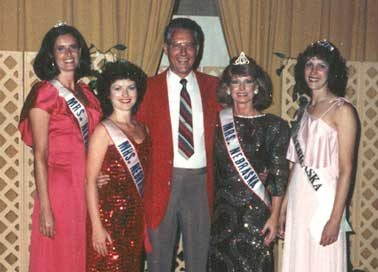
Mel Mains surrounded by Mrs. Nebraskan’s 1985
KD: Yes. There was also Joe Kinney, I don’t know if you remember that. And also Linda Bierman and Bruce Coplin.
Q: I remember all those names. I used to see Bruce Coplin at the Zoo Bar now and then, the ‘Oldest Blues Bar West of the Mississippi.’
KD: Oh, that was his favorite place. As a matter of fact that’s where he got re-married! We went down to his wedding there. And Ken Siemek, he was the sports announcer there at 10/11 and then he filled in for weather one time, and now he’s been there for something like 25 years or so.
Q: So tell me: Are you a football fan?
KD: I wouldn’t say ‘big’, but obviously I watch as it goes along. We go to games every year. When I came here in 1974, Coach Osborne was, obviously, there as coach and we lived through disappointing years where we’d be undefeated until the Oklahoma game and we would lose. And then the one famous year where we played Oklahoma in ’78 and won, and then went and lost to Missouri…then we played Oklahoma again in the Orange Bowl and lost. But over the years it was fun.
Some of the plays that Coach Osborne came up with: the famous Bummerooski back in the ’70’s, the famous Missouri game ten, twelve years ago when the player kicked the ball backwards and they won it in overtime. We’ve recently seen them try the West Coast Offense, and then during the ’70s we did the “combine demolition derby,” as my wife calls it, straight up the middle. Just straight up the middle. But it’s been fun to watch them change over the years. And then they became disgruntled with Frank Solich -it wasn’t good enough for them to have 10 wins and 3 losses- they wanted an undefeated season. The fans are a little fickle and tough to deal with, but it’s certainly Husker Nation.
And they’ve added on to the stadium over the years and gotten bigger and bigger, and the fans still keep on coming. And it’s fun to see how the rivalries changed over the years. All of a sudden Colorado became the rivalry and we were, “What’s that all about?” Then momentarily it was K-State or someone like that. But the glory of the Oklahoma-Nebraska game? I miss the Big 8. It was so important, that last game. When it became the Big 12 it lost some of the luster for me, but I understood they had to do it.
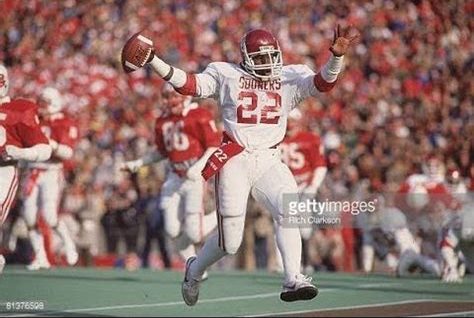
Q: I’ve been talking to a host of players and staff members and coaches about the last, dominating years of the Big 8 era…
KD: To hear you talk to that many people makes me wonder why you’d want to talk to me? And I’m the guy who doesn’t even go to all the games every year! I’m not a sports nut.
Q: Well, I contacted you for a number of reasons, because you used to teach that Intro to Meteorology class over at Avery Hall, that building right next to the stadium, correct?
KD: Right in that auditorium.
Q: I think it’s pretty neat that a guy can get ahold of his favorite instructor from the University experience, as well as the fact that you spent so many years in the actual shadow of Memorial Stadium, being directly adjacent to South Stadium there. And then add the fact that you brought a unique, positively entertaining educational experience; you made it come alive! Weather dominates just as much public discourse or more than Nebraska football, so I’d like to get your ‘take’ on both.
KD: Well, as an aside, I now not only work for the Chancellor in the Chancellor’s Speakers Bureau (I give talks across the region on three topics each year), but I’ve also been doing schools. And I’ve particularly been choosing the 2nd Grade. All I have to do is yell out, ‘Hi, my name is Ken.’ And they all scream. (laughs) Everybody’s hand goes up. ‘Can I have a volunteer?’ Every hand goes up. And in second grade they love you. There’s no failing grades to give, there’s no parties they’re thinking of going to, there’s no football. They’re just with you 100% of the way. I missed it: I shouldn’t have been teaching college all this time. (laughs)
Q: Well, with the little bit of A.D.D. I likely possessed, you kept me engrossed. (laughs)
KD: I enjoy your saying that, because I feel that I’m trying to reach everybody regardless of their background, because they can at least just look at what’s going on around them.
I arrived here in the seventies -1974- so I came here as a twenty-five year old and have enjoyed a long career. And at conventions I run into old students who now have gray hair and I say, ‘How old are you?’ And they say, “I’m fifty.’ And I think, ‘Wow, that’s how long I’ve been at this?’
And I also have a radio show every two weeks on KLIN and I’m a called ‘The Climate Guru.’ And like I said earlier, I’m not a real sports fanatic, but it’s amazing that I became a sports fanatic because of Tom Osborne and the way the football program was presented.
And you had Barry Switzer, on the other end, but Coach Osborne brought so much dignity to sports. He gave it a lot of respect, to me. And I remember, with several students he would physically come over. I remember several times Coach Osborne had come over to see if one of the students was in their class, because he was upset. We used to give little notes, we used to fill them out for the athletic department, “Is so-and-so attending class?” And I’d put down, I’d write, ‘So-and-so has only been here once or twice in the last month,’ and then I wondered what was going to happen to the poor kid. And the next thing I know I see Tom Osborne in the back of the room, because he’d told this kid, “You’re either going to get with it or you’re not going to be on the team.” And they listened to him as a father figure, and I don’t know how many coaches could get away with that.
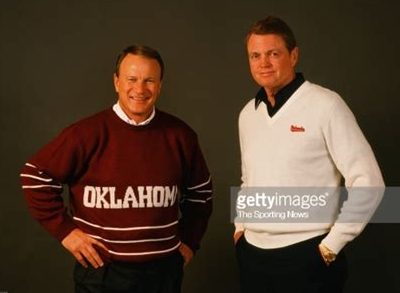
Q: I discovered a curious thing about Coach Osborne recently: he’s not very afraid of lightning.
KD: Oh!?
Q: There would be players and trainers running to the locker room, yet Coach Osborne would still be standing there at midfield, upright, tall and straight as an arrow, seemingly daring the atmospheric electrostatics to do their thing. (laughing) And oddly, I believe that a dear uncle of his was actually killed by lightning strike.
KD: Tom Osborne had a great philosophy of “whatever will be, will be.” And he also had an amazing ability to remember people. He would park in the same parking lot that I did, over at the south end of the stadium. And I don’t know how he knew me, but I would walk by (and he was always so understated), “Hi, how are you, Ken? Well, hope you’re keeping track of the weather.” And I said, ‘I sure am.’ He always seemed so humble.
And in the middle of the Lawrence Phillips thing, right around the corner they’d have ESPN News and cameras and lights and they’re interviewing people, and he’d just get right out of his car and, ”It’s just another day at work.” He’s an amazing man. He didn’t have that football-coach aura about him only, it was just like he was running a family business.
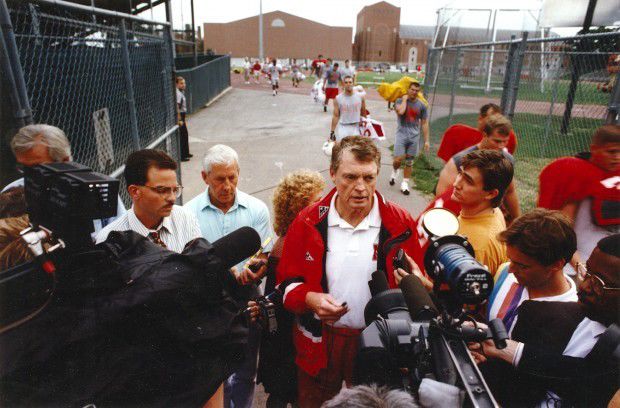
Q: It’s funny you recall the ESPN/Lawrence Phillips thing, because I recall you teaching about the concept of ‘Urban Heat Islands’: how specific weather phenomena occur simply from the reflective heat a city‘s concrete and pavement could throw off over the course of a hot, summer day? Well, the time you just described was generating so much figurative heat, per se, the Lawrence Phillips situation and what was emanating over at the football stadium next door…and here you were teaching at Avery Hall, right in the shadow of all of that. I think it’s a strange, unique metaphor of sorts.
KD: My office actually looked out at the stadium for many, many years. I had the honor of being the office closest to the stadium; there was no other academic office as close as mine. And underneath was a classroom, so my office was the only one as close. My son remembers going to my office in his grade school years, and he’d sit in my office with the door locked and he’d read books or comic books or do drawings. And at halftime on Saturdays I’d get a pass out and walk over to the building (back then you could walk into the stadium at halftime without a ticket) and he remembers coming in and sitting on my lap, just finding a notch somewhere we could squeeze in. He said that was one of his fondest memories: going down there on a Saturday. And he takes his kids now. He takes two or three kids to the games in the fall.
Q: Man, that’s a memory to cherish.
KD: I don’t know if we’d have had the same feeling if it was Oklahoma. I think it would wear on me, ‘Boomer Sooner’ all the time, the different coaches and the styles. I just felt like I was part of the family, accepted by the athletic program. I knew Butch Hug for years, and one time they invited me over so I could see their Friday planning. So I went over there on Friday and had lunch with everybody, and then in the afternoon sat in with the coaches as they talked about their game plan. And I raised my hand and said, ‘I’ve got all these notes down, can I just give them to the opposing team? How much do you think I would get for them?’ They all laughed. They were very nice people and they still are to this day. And Larry the Cable Guy had a show in Memorial Stadium, too. Did you know about that?
Q: You were the weather consultant for that, right?
KD: Yeah, it was really nice, because Butch Hug and the Mayor’s Office both recommended me, so I got the gig and I got to work there. And Butch Hug is another one of them, just a low-key guy, nothing fazes him. It was so much fun to be back because I work on East Campus now, and to be back in the stadium for several days with Butch Hug and watching the stadium come alive for that event. When Garth Brooks came to town to meet the team, they invited me over, too.
And another thing, I think Tom Osborne has an incredible mind where he remembers everybody -or maybe I’m strange and he remembers that- I have no idea. (laughs) I don’t think today he would recognize me because it’s been ten years.
Q: You might be surprised, Professor. Now, I’d like to broach the parallels and interconnections between the football program and our weather in Nebraska. Here was a smaller population to draw from, so we had to draw on elements outside of our region with players from other states far and wide, and they got together and created quite a ‘storm’, to put it in a way. One might even say it was a ‘perfect storm’, to borrow from Sebastian Junger’s book of the same name. It seems that perfect storm might parallel what you once said about a typical Nebraska thunderstorm, which has its genesis from all sorts of places: you’ve got the wet air coming over the Rockies, the cold coming from Canada, the moist air and condensation nuclei coming up from the Gulf of Mexico. And it all seems to have its confluence, its eventual destination, its meeting place, in the rendezvous point of Nebraska. I believe you once said, “Nebraska is the hardest place in America to predict the weather.” Is that correct?
KD: It is. And I’m working on an article right now… its simple title is “The Climate of Nebraska: In The Middle Of It All.” And that’s because we are truly in the middle. And the argument starts out with, “We do not own a climate. We are the only state in the United States that does not have a climate. There is no west coast marine climate here. There is no mountain climate here. There is no gulf coast climate here. There is no New England climate here. There is no snow belt climate here. We’re not the snow belt. We’re not the sunbelt. We’re not the tropical southeast. We’re not the hurricane climate. We have no climate. We’re not the arctic climate. We’re not the polar climate.” So what we are is the crossroads for all the other climates passing over us. And that creates quite a clash.
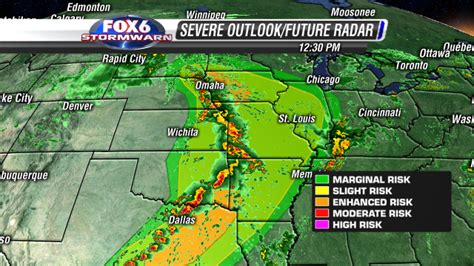
And that clash is the severe weather that occurs every year up and down the Great Plains, and it makes it extremely difficult to forecast. For example, a week ago I went inside for lunch and it was just around 70 degrees and really warm and kind of muggy. I came out from lunch and it was forty-two degrees in the middle of the afternoon: a cold front had slipped south of us. I went into the office and said, ‘What happened?’ They said, “Well, we need to go down to Nebraska City, because it’s 83 degrees there.” And I said, ‘No way!’ And we looked and it was 83. So forty-five miles to the southeast of us it was 83 degrees, and it was 42 in Lincoln and cloudy and dreary and we thought it was going to snow. But that’s what Nebraska is. Everything just kind of jostles and moves around.
And these kids come from not just rural areas, but they’re coming from urban areas like suburban Chicago and from the New York City/New Jersey areas, and a lot of them are coming from inner-city environments. So they were not only having a change in culture, but a change in weather and climate. It must have been pretty scary for these kids, for them to come from Hawaii or San Diego. And here there were some kids in class from the L.A. basin and they had ozone alerts and pollution -so they were kind of aware of pollution- but when they were out here they were not going to have ozone alerts with our extreme climates.
Q: Taking all that variance of weather into account, do you think dealing with that creates a resilience, points to a braveness, a stealth of sorts that becomes instilled in Midwesterners?
KD: Oh, yes.
Q: And I forgot to ask, but where did you grow up? Are you a native Nebraskan?
KD: I grew up in Chicago.
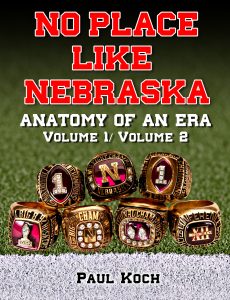
Available on Amazon.com
Q: So what brought you to Nebraska?
KD: The weather. Growing up in Chicago, growing up in inner-city Chicago I didn’t know what a cow looked like other than in a comic book. One thing I always wondered was, ‘Why don’t they have cows at the zoo?’, you know? I’ve never been able to figure that one out. So I’d never seen a cow, because they were not at the zoo and I lived inner-city, walked everywhere and took a bus everywhere. I lived within sight of downtown Chicago.
But I loved the weather and I started out as a city planner. I worked at the Northeastern Illinois Planning Commission and I wound up staying after work just to watch the weather some nights. So I went back to graduate school and wound up at the University of Toronto, Canada’s largest city, and living in a high rise apartment. And again, living as an urban person I didn’t need a car, took the subway or the bus or walked everywhere.
So this is the most rural environment I’ve ever lived in. It was the tiniest little town when I moved into Lincoln, but I came here because I knew it would be the best weather. And people had told me about it. I didn’t come here for the football team, but I always kidded people. I said, ‘The football team is number one, but weather must be number two. Because there are only two things that everyone talks about in the state of Nebraska: football and the weather.’ And it doesn’t matter, you go into any single bar, any restaurant, any morning café on Monday morning after a football game, and all they are talking about is football and weather. Those are the two national pastimes in the state of Nebraska.
Q: So philosophy and politics and current events takes a backseat to those two?
KD: Yeah, and in any other city it might be politics, but they’ve never gotten around to politics here. Everywhere you go in Nebraska it’s always just weather or sports. I would be in Kimball, Nebraska, just a couple hours from Denver and Cheyenne, and you walk into a store and there the Husker game is playing on a Saturday. And you go in and the people are wearing red and they have the Husker schedule in the gas station. You’re in Sidney, Nebraska -four miles from Wyoming- and you walk into the gas station and they have the Husker schedule up with all the scores all written down.
The whole state. It’s the state’s team. I don’t know if other states are like that, in Ohio if you go to Toledo and you’re going to see that about Ohio State? If you go to Wheeling at the West Virginia and Ohio border, if you’d see the schedule with the scores written on it? I don’t know if you’d see that. It just unifies the entire state. The entire state is interested in the football team as opposed to just part of the state. And it’s not like UN-Omaha is competition. It’s not like Texas and Texas A&M or Oklahoma and Oklahoma State, or Kansas State and Kansas, Michigan and Michigan State. But it’s a unified state when it comes to sports and weather.
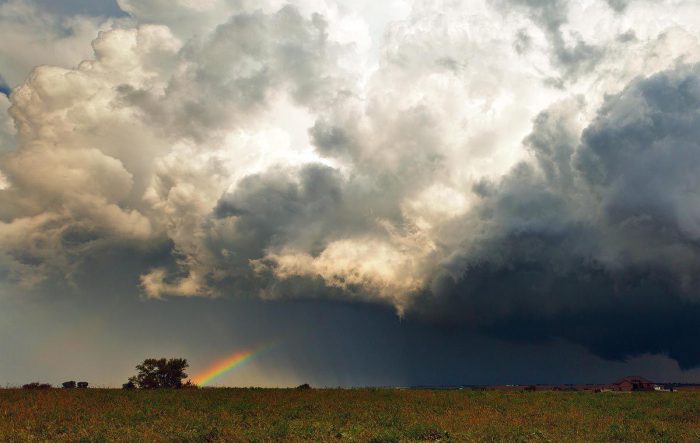
Q: And you, being an urban Chicago kid, was there anything peculiar or different about the typical Nebraskan that stood out to you when you first arrived?
KD: Yeah, they were nice. (laughs) I wasn’t used to that. My dad once came to visit from Chicago and I can remember when I had to be ‘the parent.’ It was the most embarrassing thing in my life, because I had to be the parent, because I had to remind ‘the child,’ my parent, to be nice. We’d be in a restaurant and he’d yell out, “Hey! I need another cup of coffee. Over here!” Real loud like that, “Hey!” And I’d go, ‘Dad, you don’t do that in Nebraska.’ And it was constantly like that, so he had to flip the switch. And eventually he figured it out. And he liked it here so much that when he retired my mom and dad moved here to Lincoln from Chicago. But at first he did not fit in. I was always a little embarrassed because he was always in a hurry, always aggressive, always impatient, always snapping at the people in a restaurant. And he just didn’t quite get it. And over time he figured it out and he was like, “Oh, I can be like them.” And he became like them, and as he became more like a Nebraskan he didn’t fit in Chicago anymore, so he had to leave.
Q: Incredible.
KD: Now, when I go back to Chicago -and I go quite often- we took our ten year old granddaughter there last summer and she was appalled by the crowds of people. She said, “Nobody looks at each other.” And I said, ‘No, they don’t. The crowds are too big, you don’t do face contact. And nobody says anything to anybody, they don’t even say, “Excuse me.” They don’t even say, “Hi”. It’s a big city.’ And she said, “I don’t think I could live here.” But after a while she became impressed with the tall skyscrapers and the excitement of the city, and by the time we left Chicago she said, “I think I’d like to live in a city like Chicago.” And then as we made our way back we stopped at the world’s largest truck stop somewhere in eastern Iowa, and she said, “I‘m kind of liking Iowa now.” I was, ‘Okay!’ (laughing) And then when we got back to Nebraska she goes, “You know what, I think I’m more at home in Nebraska.” (laughs) But Chicago is the third-largest city -used to be second-largest- it’s crowded on the freeway, and everywhere there’s lines and people…
To be continued tomorrow….
Copyright @ 2013 Thermopylae Press. All Rights Reserved.
Photo Credits : Unknown Original Sources/Updates Welcomed
Author assumes no responsibility for interviewee errors or misstatements of fact.